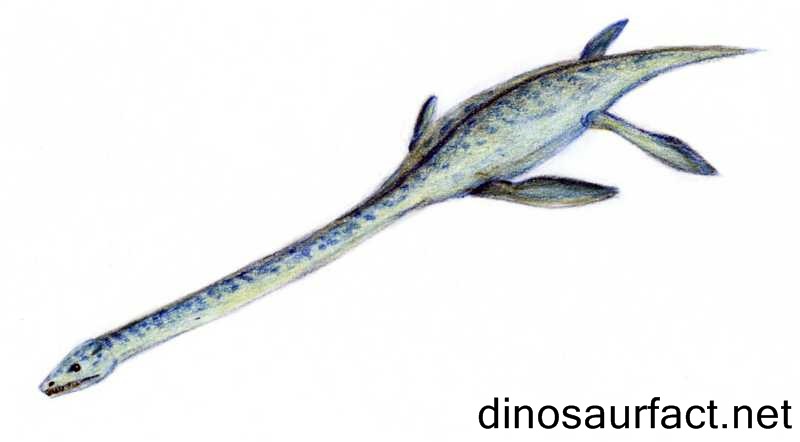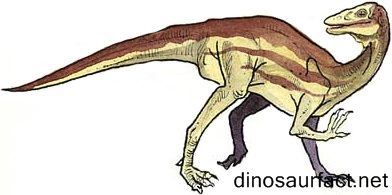The Libonectes |
 After the success of the film ‘ Jurassic Park ' many children are very much interested in collecting information regarding the different varieties of dinosaurs that lived millions of years ago. The Libonectes were not of the dinosaur specie category but under the marine reptile family called plesiosaurs. Plesiosaurs are marine reptiles lived during the early Jurassic period or Triassic period. Even though plesiosaurs were believed to be vanished, some people claim that animals alleged to be living in certain lakes might be living plesiosaurs. They make a claim seeing the animal Nessie, which is known to be living in Scotland, Loch Ness and in the Champlain Lake in the United States of America. Plesiosaurs were classified into two major sub-groups. They are larger headed, short-necked ‘pilosaurids' and small headed, long-necked elasmosaurs. Libonectes belong to the second category (i.e.) it had a long neck with small head. Even though, this classification has been made, some researchers do not agree upon this classification of Plesiosaurs. This is because, according to them some of the plesiosaurs falling under the first category (i.e.) pilosaurids also were to a certain extent related to the second category elasmosaurs in their appearance. Different dinosaurs coming under the category of pilosaurids were ranged from 2.4 to14m long (i.e.) 8 to 46 feet long in size. With the evolution, the pilosaurids with longer neck (i.e.) elasmosaurs tended to get even longer necks. All these had short tail and broad body. Libonectes is an extinct genus belonging to the plesiosaur order. It was known to have been lived in the late Cretaceous period. It was known to have been lived around 65 million years ago. It was an omnivorous (i.e.) it would have eaten both meat and plants. From the fossils of Libonectes, it was found that it can grow around 23-47 feet long (i.e.) 7-14m long and it was related to Elasmosaurus since it possessed the same body structure as that of the Elasmosaurus. It had large flippers and a short tail. Its skull had forward facing long teeth perfectly designed for catching squid and slippery fish. It would have kept its body strong by swallowing rocks and its four strong flippers would have helped it to swim quickly. It is believed that it controlled its buoyancy by consuming the bottom sea rocks. It was once believed that plesiosaurs would have been able to raise their neck above the surface of the water. But, from the fossils of Libonectes, it was found that the base of the neck was too stiff. So it might have able to move its head only slightly up and down and side to side. Libonectes is classified under Animalia kingdom, Chordata phylum, Sauropsida class, plesiosauria order and under the sub order plesiosauroidea and it belonged to the family of elamosauridae. In Texas, the specimen of different dinosaurs is being kept for display and they also have the skull of Libonectes. According to them, they found the specimen near Cedar hills in the Dallas county of Texas. Hope you might have got the required information regarding Libonectes |
domingo, 21 de marzo de 2010
sábado, 6 de marzo de 2010
The Segisaurus |
 Nowadays, kids are very much interested in learning more information about different types of dinosaurs especially after the great hit of Jurassic park film. There are different types of dinosaurs like killer dinosaurs, plant eating dinosaurs, armored dinosaurs, duck bills dinosaurs and flying dinosaurs. One such dinosaur is segisaurus, which is a meat eater. Segisaurus was known to be lived in the early Jurassic period in North America (i.e.) 200 million years ago. The term ‘Segisaurus' represents reptile of Segi. Segi is nothing but the location from where this dinosaur was discovered. The term is spelled as ‘Say-ee-sore-uss'. Segisaurus was known to have been one meter (i.e.) three feet long. Researchers say that Segisaurus would have weighed around eleven pounds. This dinosaur belongs to the Theropoda class of dinosaurs. As said earlier, it is a meat eater and it would have eaten small animals. Since it belonged to a very early period, only a few bones of Segisaurus were found and from the bones it was discovered that it would have been a fast runner and it would have been able to dart from one side to another when it hunted the prey. The remains of Segisaurus was found by Max Littlesalt in the year 1933 in Segi Canyon, after finding the bones he reported it to the archeologists and research was done using the remains. The research was done by Charles Lewis Camp, who was a paleontologist. The remains consisted of portions of pelvis, limbs and vertebrae. It was found that Segisaurus would have resembled the well-known dinosaur called coelophysis. The only difference between these two dinosaurs would have been the bone type. Segisaurus would have had a solid bone, while coelophysis would have had a hollow bone. From further research, it was found that Segisaurus would have been related closely to procompsognathus. It was found that it would have been in the size of a goose, it was insectivorous and nimble, and even it might have consumed meat as well. It would have had a bird like body structure with an elongated and flexible neck and stubbiest body. Segisaurus might have had powerful legs with three toes and the leg would have been long as compared to the length of its body. It also had a long forearms and long tail. Scientists discovered clavicles in the bone of Segisaurus and they found it to be strange since clavicles were present only in dinosaurs that belonged to much earlier era. When the specimen of Segisaurus found it was linked with a sitting hen since the position of the dinosaur showed that. Other dinosaurs generally use the position of a sitting bird for staying sheltered and for sleeping. From the specimen it was found that Segisaurus would have been submerged in a sand layer, when it was sitting because of which it would have died. Along with the specimen of Segisaurus no other den or nest materials was found and so its hatching habits were not known. Very recently (i.e.) in September 2005, the remains of Segisaurus was again investigated and scientists found that it would have been a coelophysoid and would have been a relative of procompsognathus. |